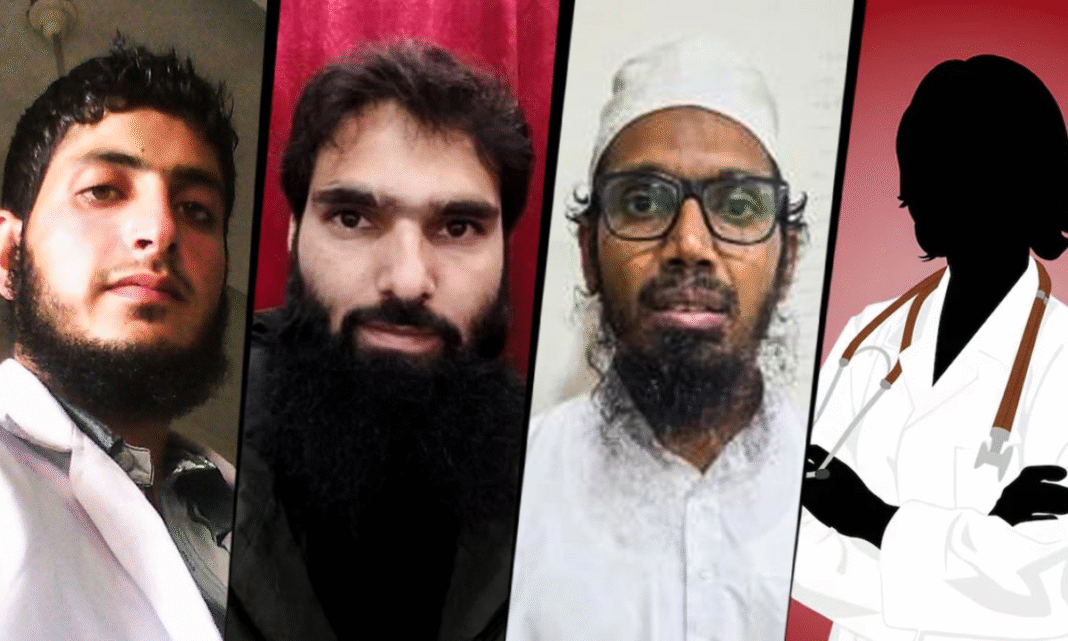New Delhi, India – 11 November 2025
In a shocking turn of events that has rattled India’s counter-terror framework, the deadly car explosion near the iconic Red Fort in Delhi is now being linked to a sophisticated “white-collar” terror module involving medical professionals. This development highlights a dramatic shift in terror-networks, from street operatives to radicalised professionals operating with covert access and technical know-how.
Blast and Immediate Aftermath
On Monday evening, a white Hyundai i20 moved slowly into a parking area near the Red Fort Metro station. At approximately 6:52 pm, the vehicle detonated with devastating effect—killing at least nine people and injuring around 20 others, according to initial police and hospital sources.
Forensics indicated that the car contained a large quantity of ammonium-nitrate based explosives; investigators believe the blast was executed after the suspect realised his module was compromised.
The explosion forced closure of nearby roads and a full-scale emergency response by the Delhi Police and National Investigation Agency.
The White-Collar Module: Doctors in the Dock
What is particularly alarming to security agencies is the profile of the suspected operatives. Over the past 48 hours, arrests have been made of multiple individuals including some medical doctors—graduate professionals who until recently would not have raised suspicion. Reports identify key suspects such as Dr Umar Mohammad, Dr Muzammil Shakeel and Dr Adil Rather, all alleged to be part of a network linked to the Pakistan-based terror outfit Jaish‑e‑Mohammed (JeM).
According to the Jammu & Kashmir Police and Delhi Police, this module was actively planning terror operations, recruiting professionals and using education and professional credibility as a cover.
One of the doctors is believed to have kept logistical control over the explosive haul in Faridabad, which preceded the Red Fort blast, while the vehicle used in the explosion is tied back to this network through a complex series of ownership transfers.
The term “white-collar terror ecosystem” is now being used by investigators to describe this emerging trend of radicalised educated professionals engaging in terror logistics, planning and execution.
Explosive Haul, Multi-State Links
Prior to the Red Fort blast, authorities had seized hundreds of kilograms of ammonium nitrates and related bomb-making material in Faridabad, Haryana. Investigators say the Faridabad operation is linked to the Delhi attack and served as the inventory for explosives. The car used in the blast is reported to have been bought, sold multiple times across states before arriving in Delhi — indicating a deliberate attempt at obfuscation.
The multi-state involvement spans Jammu & Kashmir, Uttar Pradesh, Haryana and the national capital — showing capability for interstate terror logistics and planning.
Political Response & National Security Alert
India’s central government has taken note of the incident as more than just a bombing — but a systemic threat challenge. The Prime Minister issued a statement vowing that all responsible will be brought to justice.
Security agencies have raised the threat level in Delhi and adjoining regions, with checks intensified across entry points, parking zones near sensitive monuments, and vehicle-screening protocols updated. The Red Fort blast has triggered a wider review of how educated professionals might be radicalised and utilised in terror modules.
Why The Shift in Terror Recruitment Matters
For decades, terror-networks depended largely on semi-literate operatives or low-profile foot-soldiers. The current pattern — involving doctors, engineers or professionals — represents a strategic change. According to analysts, such individuals bring:
-
Greater mobility and credibility
-
Ability to operate under cover of profession
-
Technical or logistical competence to handle explosives or finance
-
Access to cross-state travel and resources
The “white-collar” model allows terror groups to reduce detection risk, utilise trusted professionals as planners or facilitators and blur the lines between conventional professions and radical activity.
What Comes Next: Vigilance & Accountability
As the investigation progresses, several questions will be critical:
-
How these professionals were radicalised and recruited: what networks and messaging were employed.
-
How the technical materials and explosives were procured, stored and transported.
-
How many more such modules might be operating nationally: the Red Fort incident may only be the tip of the iceberg.
-
What security protocols must be updated given the new threat profile of educated professionals.
For residents and visitors in high-density urban zones, practical vigilance is required — report suspicious vehicles parked for long durations, check for unexplained transfers of professional credentials and stay aware of alerts from law enforcement.


